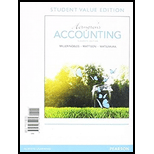
Payback period, Accounting
All the above are the methods of capital budgeting which are having separate principles of deciding on which investment shall be taken up:
Payback period: This method is based on principle that the projects which recover which initial
Accounting rate of return: This method computes the simple rate of return on the average investment involved in the projects and the projects which provides the highest return shall be accepted.
Net Present value: This method is based on principle of time value of money and takes decision on the basis of net residual
Internal return of return: This method also suggest the rate of return which the investment will realize after considering the present value of cash inflows and outflows. The
Profitability Index: Profitability index is also a proportion of present value of cash inflows and initial investment. The project with higher ratio shall be accepted over the other projects.
Requirement1-a:
Thepayback period of the project shall be determined.
Requirement 1-b:
The Accounting rate of return of the project shall be computed.
Requirement1-c:
The net present value of project at 10% discount rate shall be computed.
Requirement1-d:
The Internal rate of return shall be determined
Requirement1-e:
The Profitability index of the project shall be determined.
Requirement2:
The decision on the project acceptance or rejection to be taken.
Want to see the full answer?
Check out a sample textbook solution
Chapter 26 Solutions
Horngren's Accounting, Student Value Edition Plus MyAccountingLab with Pearson eText, Access Card Package
- What is the activity rate for the batch?arrow_forwardPlease explain the correct approach for solving this general accounting question.arrow_forwardUnion National Bank has an issue of preferred stock with a $6.20 stated dividend that just sold for $105 per share. What is the bank’s cost of preferred stock? Financial accounting problemarrow_forward

 AccountingAccountingISBN:9781337272094Author:WARREN, Carl S., Reeve, James M., Duchac, Jonathan E.Publisher:Cengage Learning,
AccountingAccountingISBN:9781337272094Author:WARREN, Carl S., Reeve, James M., Duchac, Jonathan E.Publisher:Cengage Learning, Accounting Information SystemsAccountingISBN:9781337619202Author:Hall, James A.Publisher:Cengage Learning,
Accounting Information SystemsAccountingISBN:9781337619202Author:Hall, James A.Publisher:Cengage Learning, Horngren's Cost Accounting: A Managerial Emphasis...AccountingISBN:9780134475585Author:Srikant M. Datar, Madhav V. RajanPublisher:PEARSON
Horngren's Cost Accounting: A Managerial Emphasis...AccountingISBN:9780134475585Author:Srikant M. Datar, Madhav V. RajanPublisher:PEARSON Intermediate AccountingAccountingISBN:9781259722660Author:J. David Spiceland, Mark W. Nelson, Wayne M ThomasPublisher:McGraw-Hill Education
Intermediate AccountingAccountingISBN:9781259722660Author:J. David Spiceland, Mark W. Nelson, Wayne M ThomasPublisher:McGraw-Hill Education Financial and Managerial AccountingAccountingISBN:9781259726705Author:John J Wild, Ken W. Shaw, Barbara Chiappetta Fundamental Accounting PrinciplesPublisher:McGraw-Hill Education
Financial and Managerial AccountingAccountingISBN:9781259726705Author:John J Wild, Ken W. Shaw, Barbara Chiappetta Fundamental Accounting PrinciplesPublisher:McGraw-Hill Education





